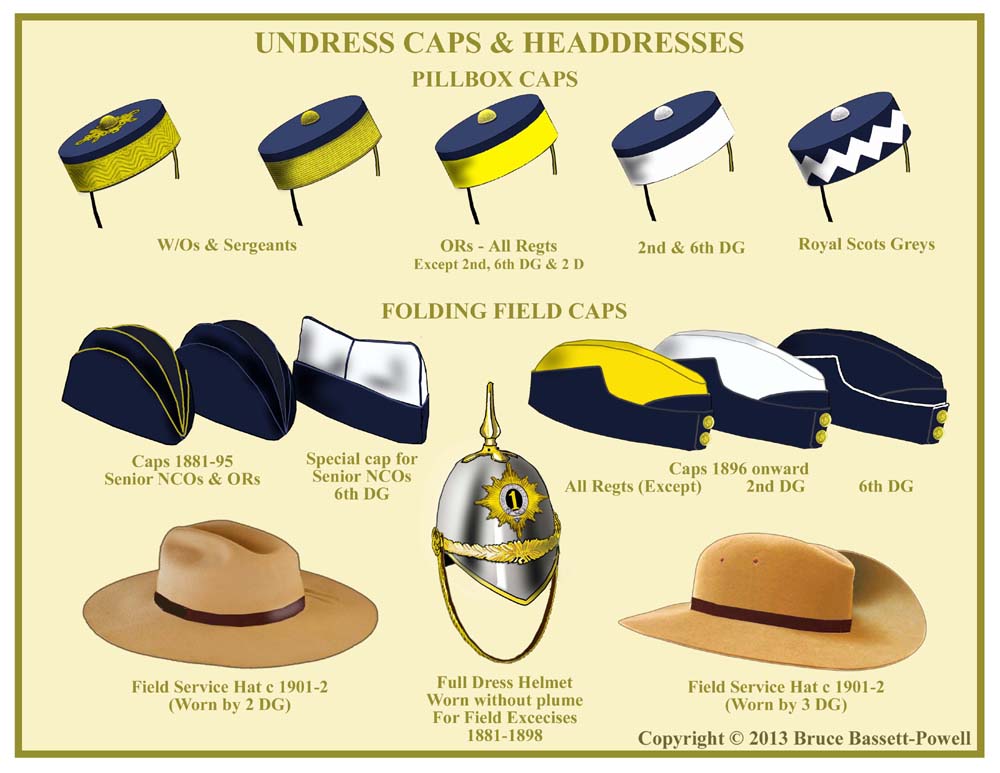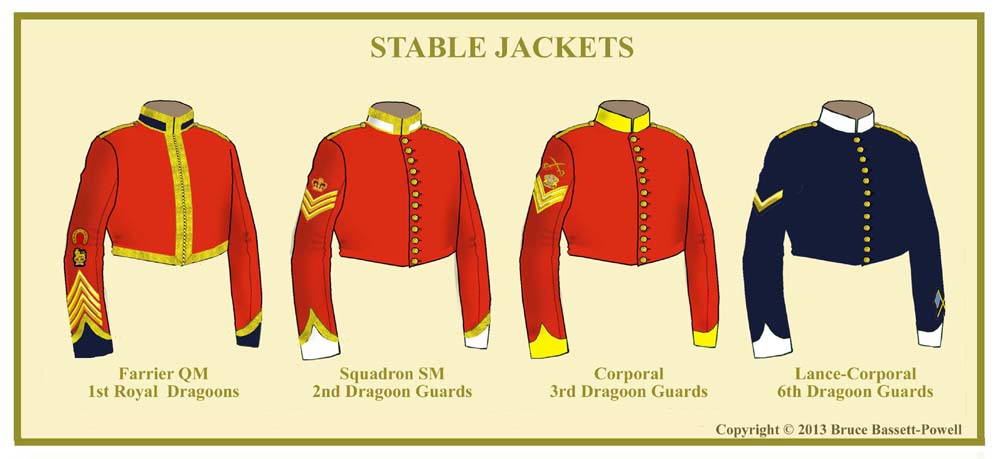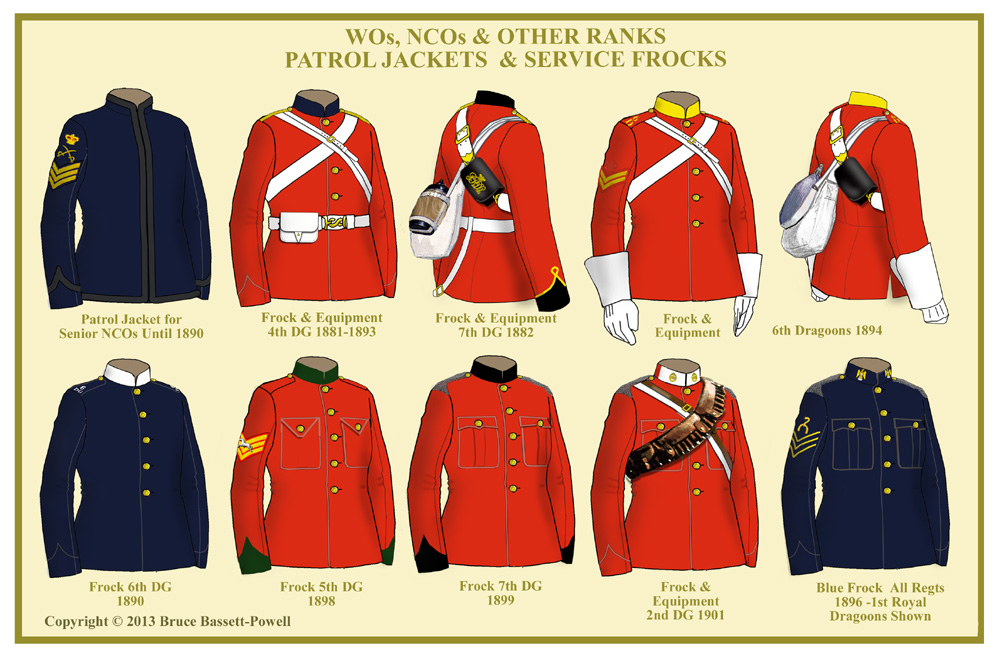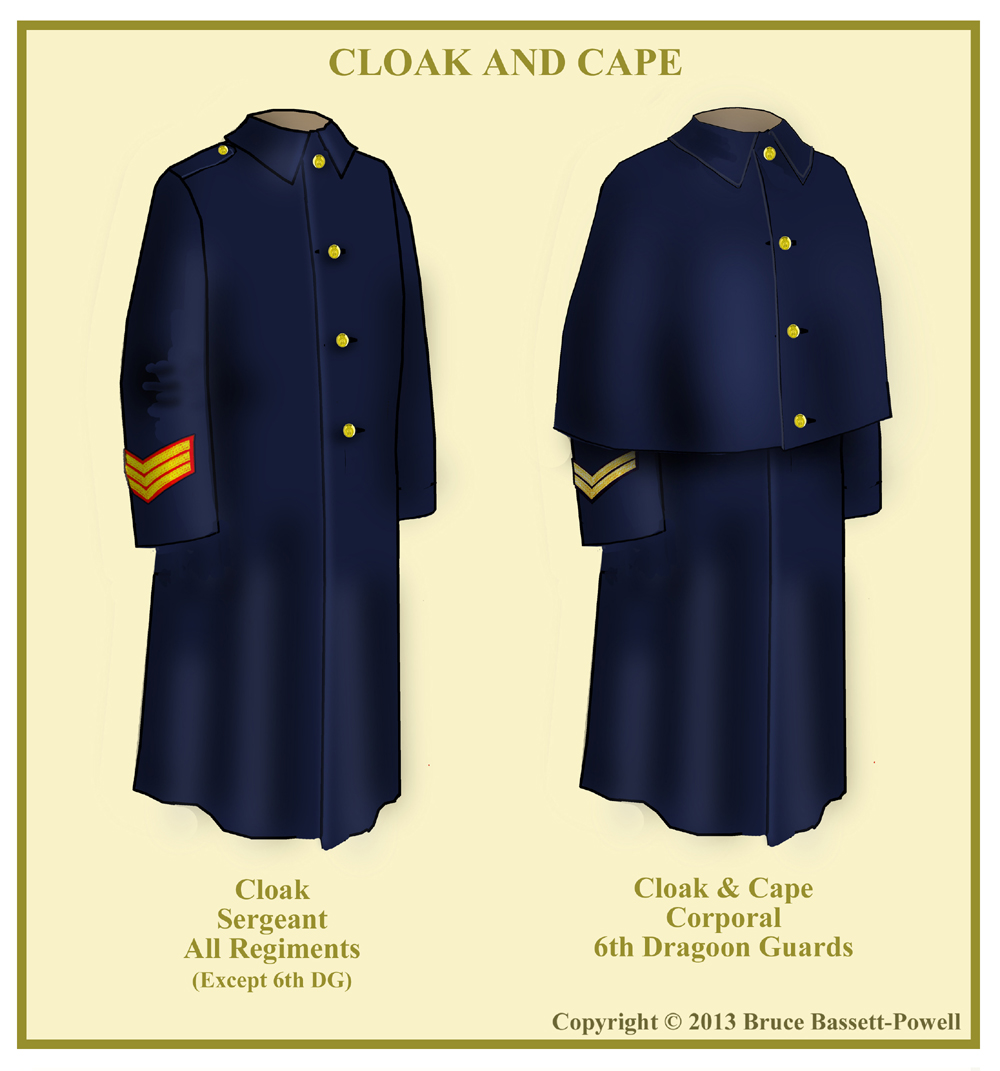HEAVY CAVALRY UNIFORMS, ARMS & EQUIPMENT - DRAGOON GUARDS & DRAGOONS
CAPS, JACKETS & CLOAKS WORN BY OTHER RANKS
UNDRESS CAPS
The pillbox or peakless round forage cap was ubiquitous for other ranks in all branches of the army except the infantry. It was generally blue with a yellow worsted band & button and for the cavalry including Dragoon Guards and Dragoons this was the case. The exception was 2nd and 6th Dragoon Guards which had white bands and buttons and the 2nd Dragoons (Royal Scots Greys) who had their famous white vandyked band. For ranks above corporal the band and top were of regimental gold lace, the same as for officers. In some regiments such as the 1st DG and 4th DG, sergeants below TSM/SSM had a plain gold netted button only. The cap was abolished in 1897.
In the early 1880s the folding field cap or Torin cap was being worn by other ranks in some regiments. In most cases it was worn without a badge. Senior NCOs caps had gold piping on the welts. Photographs show it being worn overseas more than at home stations. Warrant officers of the 6th Dragoon Guards were allowed to wear a cap similar to the ‘Tent’ hat worn by officers of the 10th Hussars amongst others, with a white body piped in blue. It appears not to have been worn after 1893.
The folding field cap with flaps appeared in 1896 and was universally issued. It had, for most regiments, a yellow body and blue flaps and peak. It had a white body in the 2nd DG and white piping on the flaps in the 6th DG. There is evidence that when some regiments such as the 1st DG and 5th DG adopted caps in their own colours, the other ranks were issued plain blue caps. When the pillbox was discontinued, the field cap was worn in most undress situations and on exercise.
It should not be forgotten that on field exercises (and, presumably in wartime on the continent) the heavy cavalry wore the full dress helmet with plume removed and the helmet of the 1st Dragoons is shown in the illustration.
Although the folding forage cap was to be abolished by 1902, the effects of the Boer War were being made apparent at home and photographs show that by late 1900 and 1901 slouch or bush hats were being worn for some undress occasions and especially for field exercises. They were usually light tan with the left brim turned up and, increasingly a regimental badge. Some regiments such as the 2nd Dragoon Guards did not have the brim turned up. No puggaree appears to have been worn at home as a brown leather band was worn around the crown.
STABLE JACKETS
The stable jacket had been an article of clothing for British cavalrymen since the middle of the Napoleonic Wars and by 1881 it was still almost unchanged. In Dragoon Guards and Dragoons it was a plain garment in scarlet except for the 6th Dragoon Guards where it was blue. The collar and pointed cuffs were of facing colour and in velvet or cloth the same as the full dress tunic. Warrant officers and senior NCOs had collar, cuffs and the front edged in regimental gold lace. In some regiments, sergeants had only the collar and cuffs so edged. The shoulders had twisted yellow worsted cords with a brass button at the top which for senior NCOs was gold. Badges of rank and trade were worn on the sleeves in the same manner as the tunic. In some regiments (such as the 3rd Dragoon Guards) the chevrons were of padded lace, rather larger than those on the tunic and backed in facing colour. The stable jackets were worn in barracks and for walking out as well as for riding practice and certain field exercises. It is probably safe to say that the stable jacket was the most worn item in the cavalry. In 1897, after more than eighty-five years was finally abolished.
FIELD SERVICE AND UNDRESS FROCKS
Prior to 1881 the cavalry, unlike the infantry and other arms, did not have an undress frock for other ranks. This may have been because the infantry adopted them when the stable jacket was discontinued for them, the Royal Field Artillery and Royal Engineers. When the Egyptian War of 1882 started several regiments of Dragoon Guards and Dragoons were issued with a basic frock which consisted of a scarlet (blue for 6 DG) jacket with collar of facing colour, five buttons down the front and no piping. It had twisted yellow shoulder cords. Some regiments like the 7th Dragoon Guards had cuffs of facing colour with a single yellow loop above it. This garment was worn until about 1893/4 when a similar jacket was introduced, this time with side vents and shoulder straps the colour of the jacket with regimental shoulder titles the same as on the tunic. In the 6th Dragoon Guards its titles were white on blue shoulder straps. Within two years, the jacket was modified with two patch pockets with flaps on the chest and a year later with shoulder chains as worn for some time in the Indian Army and British cavalry on their khaki jackets.
The equipment worn on home service exercises and drills is shown in the illustration. Note the lack of a waist belt by 1895. With the sword scabbard now attached to the saddle it was no longer necessary to wear it over the tunic, especially for those troops in the front rank carrying lances. By 1900 cavalry were wearing the 1897 pattern ammunition bandolier which had been worn by mounted infantry at home and overseas as well as cavalry on foreign service since the first pattern of 1882. Full details of the equipment will be shown in section 11.
Warrant Officers and senior NCOs were allowed, regimentally, to wear a simple blue patrol jacket with blue mohair edging down the front, on the collar and cuffs. Some had outer breast pockets edged in mohair . By 1899 a blue version of the scarlet frock (which had been already been issued to most other mounted units) was being worn by Dragoons and Dragoon Guards and it replaced all other undress jackets for all other ranks including Warrant Officers. Note the thin width of the sergeant’s stripes which became more common toward the end of the century. They are still worn by NCOs of the Household Cavalry on No. 1 Dress.
CLOAKS & CAPES
The dark blue cloak and cape were universal for all cavalry including Dragoon Guards and Dragoons. It was the same pattern as for officers. In fact Dress Regulations stated that the officer’s pattern was the same as the men’s. It was made of heavy woollen milled cloth reaching down to the ankles. It was designed to cover the soldier and all his equipment when mounted. It had four buttons down the front and one on each shoulder strap. The cape was of the same cloth with four buttons. Unlike the officer’s cape which reached down to the knuckles it reached to just below the elbows to allow for ease of carrying arms etc. Rank insignia was worn on the lower arm (to show when the cape was worn) and was according to clothing regulations to be made of worsted material. However, it appears that most NCOs utilized the same chevrons as were worn on the tunic. (Photos show up the gold stripes clearly).






